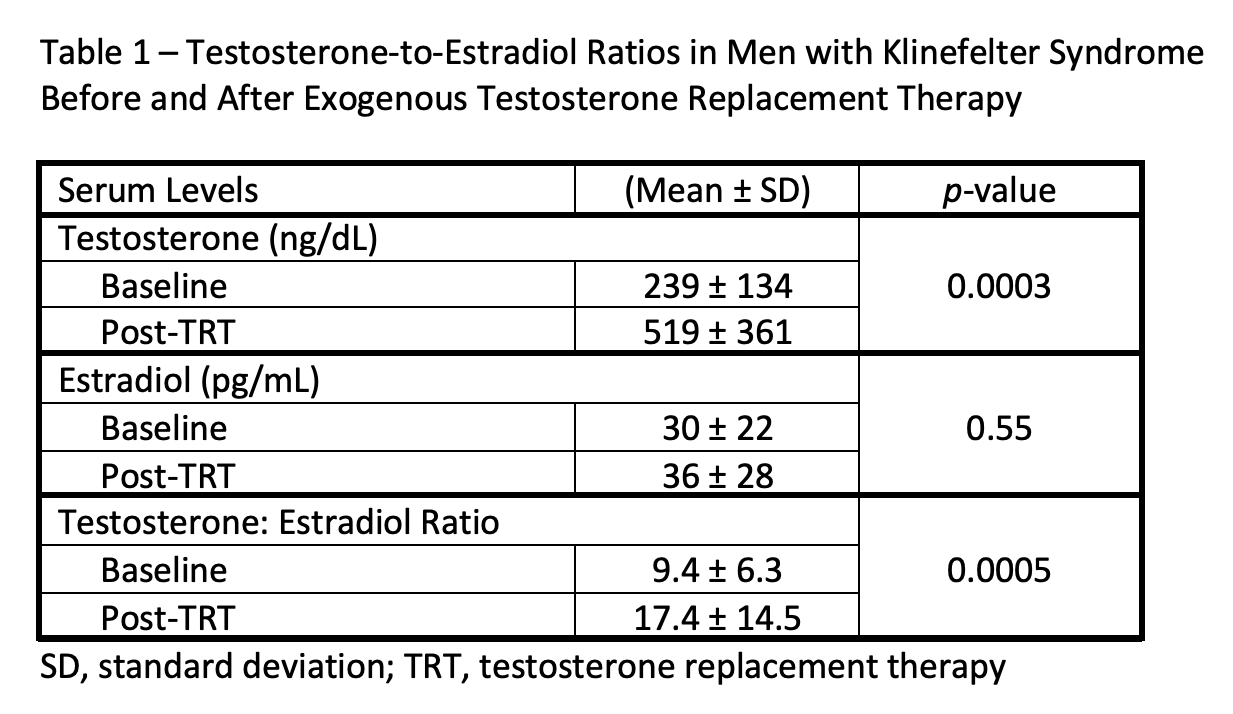Back
Poster, Podium & Video Sessions
Podium
PD36: Infertility: Basic Research & Pathophysiology
PD36-04: Aromatization of Endogenous Testosterone Occurs Primarily in Testicular Leydig Cells
Sunday, May 15, 2022
7:30 AM – 7:40 AM
Location: Room 255
Caroline Kang*, Nahid Punjani, Jessica Marinaro, Peter Schlegel, New York, NY
- CK
Podium Presenter(s)
Introduction: Endogenous testosterone (T) is produced by testicular Leydig cells that are rich in aromatase activity. Aromatization to estradiol (E2) can negatively regulate the hypothalamic-pituitary-testis (HPT) axis, thereby diminishing gonadotropin and T production as well as spermatogenesis. Exogenous T is exposed primarily to fat, muscle, and other peripheral tissues with limited exposure to testicular Leydig cells. We investigated the source of aromatization by comparing serum T:E2 ratios, as a surrogate for aromatase activity, in men with Klinefelter syndrome (KS) who have endogenous or exogenous testosterone production, that is, before and after the initiation of testosterone replacement therapy (TRT).
Methods: We performed a retrospective study of all adult men (> 20 years of age) with a diagnosis of KS undergoing sperm retrieval by microdissection testicular sperm extraction (mTESE) performed by a single surgeon at a tertiary infertility referral center between 1995-2020. Demographic data, along with hormone data (serum T and E2 levels) pre- and post-TRT were obtained from the electronic medical record. Patients not treated with TRT or with incomplete hormone data were excluded. Paired statistical analyses were completed to determine differences between hormone levels pre- and post-TRT initiation.
Results: A total of 35 men with KS were included in our final analysis. Median age was 32 years (interquartile range (IQR), 28 - 36), and median BMI was 25.9 kg/m2 (IQR, 24.6 - 30.8). The majority of our cohort was initiated on topical TRT (e.g., cream or gel; 26/35, 74.3%), while the remaining were treated with injectable or implanted TRT (9/35, 25.7%). Mean serum T increased from 239 ± 134 ng/dL to 519 ± 361 ng/dL (p = 0.0003), while mean serum E2 increased from 30 ± 22 pg/ml to 36 ± 28 pg/ml (p = 0.55) after initiation of TRT. Mean T:E2 ratio increased from 9.4 ± 6.3 to 17.4 ± 14.5 (p = 0.0005) after initiation of TRT.
Conclusions: Aromatization of T to E2 can result in suppression of the HPT axis and diminish both T production and spermatogenesis. After initiation of TRT, T:E2 ratios rose significantly due to an increase in T with relatively stable E2, suggesting that exogenous and endogenous T are not subject to the same cellular milieu and therefore differential aromatization. This finding has important implications in the treatment and counseling of men with infertility and abnormal hormone levels.
Source of Funding: CK and JS are supported in part by the Frederick J. and Theresa Dow Wallace Fund of the New York Community Trust.

Methods: We performed a retrospective study of all adult men (> 20 years of age) with a diagnosis of KS undergoing sperm retrieval by microdissection testicular sperm extraction (mTESE) performed by a single surgeon at a tertiary infertility referral center between 1995-2020. Demographic data, along with hormone data (serum T and E2 levels) pre- and post-TRT were obtained from the electronic medical record. Patients not treated with TRT or with incomplete hormone data were excluded. Paired statistical analyses were completed to determine differences between hormone levels pre- and post-TRT initiation.
Results: A total of 35 men with KS were included in our final analysis. Median age was 32 years (interquartile range (IQR), 28 - 36), and median BMI was 25.9 kg/m2 (IQR, 24.6 - 30.8). The majority of our cohort was initiated on topical TRT (e.g., cream or gel; 26/35, 74.3%), while the remaining were treated with injectable or implanted TRT (9/35, 25.7%). Mean serum T increased from 239 ± 134 ng/dL to 519 ± 361 ng/dL (p = 0.0003), while mean serum E2 increased from 30 ± 22 pg/ml to 36 ± 28 pg/ml (p = 0.55) after initiation of TRT. Mean T:E2 ratio increased from 9.4 ± 6.3 to 17.4 ± 14.5 (p = 0.0005) after initiation of TRT.
Conclusions: Aromatization of T to E2 can result in suppression of the HPT axis and diminish both T production and spermatogenesis. After initiation of TRT, T:E2 ratios rose significantly due to an increase in T with relatively stable E2, suggesting that exogenous and endogenous T are not subject to the same cellular milieu and therefore differential aromatization. This finding has important implications in the treatment and counseling of men with infertility and abnormal hormone levels.
Source of Funding: CK and JS are supported in part by the Frederick J. and Theresa Dow Wallace Fund of the New York Community Trust.


.jpg)
.jpg)